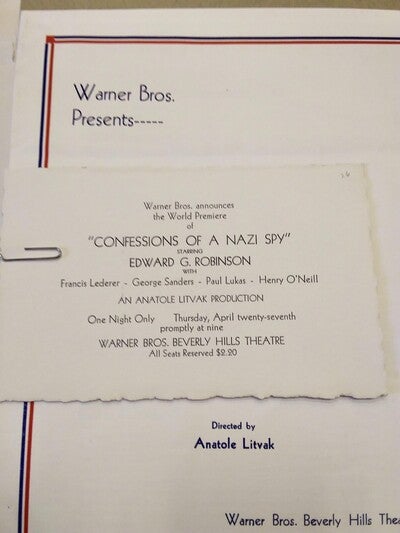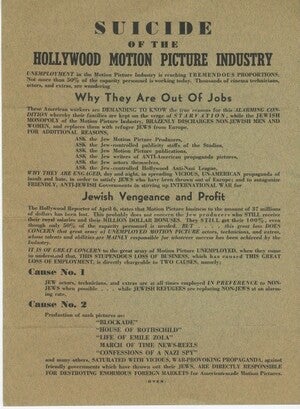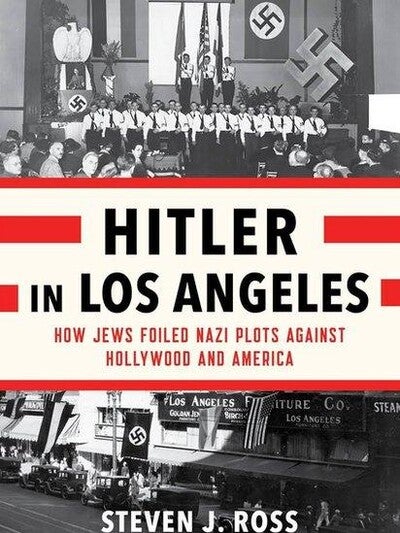My name is Matt Messbarger and I’m the Reference Coordinator for ASU Library’s Distinctive Collections. I have a Bachelors in Film Studies from the University of Kansas and a Masters in Library and Information Science from the University of Illinois at Urbana-Champaign, where I also earned a Graduate Certificate in Special Collections. I’ve written about film archives for Archival Outlook, the magazine of the Society of American Archivists, and published book reviews for Archival Issues—the Journal of the Midwest Archives Conference—as well as the Journal of Contemporary Archival Studies.

Two years ago, I was going through a folder of press screening tickets from the Starr Papers and came across one for the film “Confessions of a Nazi Spy” (1939) starring Edward G. Robinson. Paperclipped to the ticket and promotional booklet was a viciously anti-Semitic flyer entitled “Suicide of the Hollywood Motion Picture Industry.” It targeted Jewish writers and actors by name and even a prominent rabbi, imploring readers to “Wake up!”


One event chronicled in the book is the movie premiere of “Confessions of a Nazi Spy” in 1939. When I read the sequence about it I suddenly made the connection to the Starr Papers and the evidence left behind of that night. Ross writes of the danger that lurked around the film’s production. He surmises that on-set “accidents” were actually deliberate attempts on the lives of star Edward G. Robinson and director Anatole Litvak by the Silver Shirts, a fascist group with members in L.A. looking to infiltrate movie studios. Warner Brothers received countless threats during the film’s production and had to keep the set closed and the script locked from view, giving actors just a few pages a day. Nazi propaganda minister Josef Goebbels was furious that the film was being made and banned its release in Germany. On the night of the premiere the film reels were delivered to the theatre in an armored car with police escort, and armed guards were stationed on the roof and inside the theatre. As Ross put it, “On April 27, 1939, Warner Brothers Studios declared war on Germany.”
I emailed Prof. Ross about his book and sent him a digital copy of the flyer from the Starr Papers. He cites the flyer in his book but had not seen it prior to his book’s publication. He graciously answered some questions I sent him about the movie premiere, the flyer, anti-Semtisim in the U.S., and the meaning of it all.
An interview with Stephen J. Ross, author of “Hitler in Los Angeles: How Jews Foiled Nazi Plots Against Hollywood and America”:
As your book shows, in 1939 members of the German American Bund in Los Angeles distributed a vehemently anti-Semitic flyer at a film premiere that some of the most powerful people in the entertainment industry attended—including many prominent Jewish actors and studio heads. What does such willingness to go after them so directly and publicly say about the climate of anti-Semitism in L.A. and the U.S. at the time?
What is suggests is that there was a substantial core of anti-Semites in L.A. and across the U.S. As with today, hate groups proliferated the landscape; they were more visible in the 1930s because so many politicians—local and in Congress—echoed those anti-Semitic statements. Hermann Schwinn and the Bund were furious about the picture; Silver Shirts tried to sabotage production and almost killed Edward G. Robinson. And, it should be noted, anti-Semitism in L.A. went up after Pearl Harbor, not down.
For whom do you think the flyer was really intended? It attacks Hollywood’s Jews and implores the reader to “Wake up!” But considering it was distributed at the film premiere, do you think they were hoping it would get picked up in the media?
The flyer was aimed at conservative Christians. The Bund certainly hoped the press would pick up the story and spread it across the nation as yet another example of Jewish lies and Jewish perfidy in trying to get us into war. It wanted rightwing Christians to "wake up" to Jewish propaganda coming out of Hollywood. To this extent, the Bund, while not ordered to do so, was fulfilling Hitler's goal of trying to stop Hollywood from making any film that disparaged Nazism or Nazi Germany.
Would you say that the release of “Confessions of a Nazi Spy” in 1939 was influential in building support for the U.S. to go to war with Germany?
I don't think it persuaded anyone who considered themselves an isolationist at the time. It may have persuaded those who were on the fence as to whether the U.S. should sell weapons and war material to the Allies. But I don't think it changed anyone on the Right's mind.
Do you think the Warner Brothers realized what risks they were taking in making “Confessions of a Nazi Spy” considering the on-set “accidents” and general paranoia around the film’s production and release that you document?
Absolutely they knew the risks they were assuming. Jack Warner was quoted once as saying “Who gives a damn about profits when Silver Shirts are marching in front of Warner Brothers' studios?” This was one of the few times that money and profits did not matter. Making this film was a matter of conscience no matter the costs.